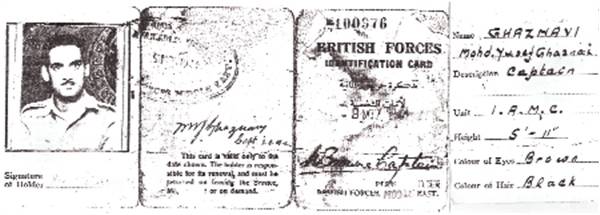
This is the British Forces identification card of then-Captain Mohammad Yousef Ghaznavi with a photograph taken on February 1, 1944. The image was submitted by his daughter, Ms Noreen Ghaznavi Mirza.
He served in the Indian Army Medical Corps of the British Forces in Monte Cassino in Italy during the World War II – a rocky hill close the city of Cassino. His field ambulance was stationed on the Monastery Hill – a hill on top of which was perhaps the world's most glorious monastery.
In 1944, the allies made four attacks on the Winter Line in Italy held by the axis forces, with the intention of reaching Rome. These assaults are collectively known as the Battle of Monte Cassino. Although the allies succeeded, the campaign was among the costliest and toughest of the World War II. The monastery was destroyed in one of the bombing raids during the battle.
In May, Prince Harry visited the site to pay homage to the forgotten heroes.
The Telegraph said the following about the battle:
“It was one of the toughest, bloodiest campaigns of the Second World War. The knee-deep mud, freezing conditions, savage close-quarters fighting and trench warfare invited comparisons with the First World War. Tens of thousands of Allied soldiers fought doggedly for five months to take Monte Cassino, a mountain topped by an ancient Benedictine monastery. It was the last major obstacle in the push for Rome, after the landings at Salerno and Anzio...
“The soldiers were drawn from many nations. Fighting alongside British troops from regiments such as the Green Howards, the Grenadier Guards and the Royal Inniskilling Fusiliers were French colonial troops from Algeria and Morocco, Sikhs and Muslims from imperial Indian battalions, Maoris from New Zealand and Polish infantrymen.”
He served in the Indian Army Medical Corps of the British Forces in Monte Cassino in Italy during the World War II – a rocky hill close the city of Cassino. His field ambulance was stationed on the Monastery Hill – a hill on top of which was perhaps the world's most glorious monastery.
In 1944, the allies made four attacks on the Winter Line in Italy held by the axis forces, with the intention of reaching Rome. These assaults are collectively known as the Battle of Monte Cassino. Although the allies succeeded, the campaign was among the costliest and toughest of the World War II. The monastery was destroyed in one of the bombing raids during the battle.
In May, Prince Harry visited the site to pay homage to the forgotten heroes.
The Telegraph said the following about the battle:
“It was one of the toughest, bloodiest campaigns of the Second World War. The knee-deep mud, freezing conditions, savage close-quarters fighting and trench warfare invited comparisons with the First World War. Tens of thousands of Allied soldiers fought doggedly for five months to take Monte Cassino, a mountain topped by an ancient Benedictine monastery. It was the last major obstacle in the push for Rome, after the landings at Salerno and Anzio...
“The soldiers were drawn from many nations. Fighting alongside British troops from regiments such as the Green Howards, the Grenadier Guards and the Royal Inniskilling Fusiliers were French colonial troops from Algeria and Morocco, Sikhs and Muslims from imperial Indian battalions, Maoris from New Zealand and Polish infantrymen.”

